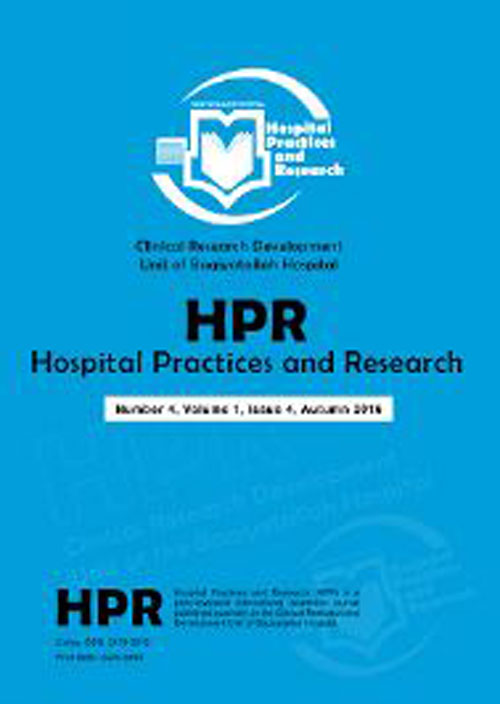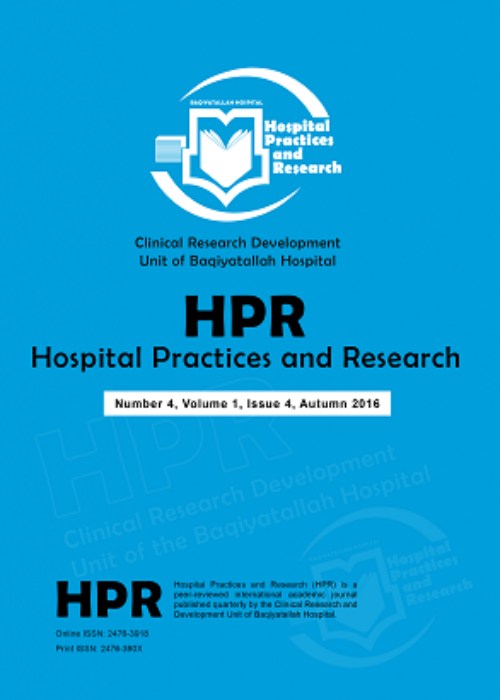فهرست مطالب

Hospital Practices and Research
Volume:5 Issue: 4, Autumn 2020
- تاریخ انتشار: 1399/11/02
- تعداد عناوین: 8
-
-
Pages 122-125
The coronavirus disease 2019 (COVID-19) pandemic has triggered an increased demand for health services. Public health facilities are becoming increasingly inadequate to provide care for the increasing COVID-19 cases. Therefore, positioning the private health facilities (PHFs) to contribute to the COVID-19 outbreak response is highly required. To position PHFs for an improved COVID-19 outbreak response, guidelines that provide clarity on the role of PHF in the COVID-19 outbreak response need to be developed. Specific regulations should be tailored towards the government acting as a financial risk protector for PHF. Also, equity in the distribution of personal protective equipment (PPE) across the public and PHF from the Federal Government should be ensured. Moreover, subsidies should be provided on PPE, including goggles, hand sanitizers, and face masks. Furthermore, the purchase of PPE could be made by PHF on a large scale at subsidized costs via the PHF professional bodies and associations. Moreover, a comprehensive assessment of the human and infrastructural capacity of PHF needs to be conducted regarding the COVID-19 response. Results obtained from such assessment would inform on the existing human resources needs of the private sector and opportunities by which PHF’s capacity could be enhanced. In addition, assessing the extent of representativeness of PHF in the existing rapid response team needs to be conducted. All challenges delimiting the active involvement of the PHF should be addressed. Additionally, adequate support systems need to be developed and well-placed to promote the involvement of the PHF in the outbreak response.
Keywords: Coronavirus, private sector, public-private partnership, Disease Outbreaks, Access to health services -
Pages 126-133
The coronavirus SARS-CoV-2 disease (COVID-19) is the most current life-threating disease that affect health and economic sectors in the world. This pandemic raises weighty and urgent ethical issues that affected patients, health care provider and health care systems. Based on medical ethics textbooks, there are four fundamental ethical principles: The principle of respect for autonomy, the principle of beneficence, the principle of non-maleficence, and the principle of justice. Medical ethics scientists have well explained these principles before with full accuracy and detail. In this review article, we discussed the ethical issues raised during the COVID-19 pandemic. Health inequity and inequality, health care rationing/triage, contact tracing technologies and data privacy, movement restriction and exit strategies, and finally COVID-19 research ethics especially clinical trials and vaccine studies could cause ethical problems during Covid-19 pandemic. In this review article, we discuss about these issues and provide some ethical solutions to these issues
Keywords: COVID-19, ethics, Health Inequity, triage, Resource Allocation, Vaccines -
Pages 134-140Background
Sepsis is a very common serious medical condition among patients admitted to the intensive care units (ICUs) that increases with age and ICU length of stay (LOS).
ObjectivesThe primary goal of this study was to estimate the mortality rate due to sepsis among adult patients admitted to the mixed medical–surgical ICUs for a long time. The secondary goal was to identify factors associated with predicting ICU mortality in individuals with long-term ICU LOS.
MethodsAdult patients admitted to the medical ICU for a long time (≥75 days) were included in this retrospective secondary analysis study. Baseline demographic, clinical, and laboratory data were recorded upon inclusion in the study.
ResultsICU mortality occurred in 78 (43.1%) patients, out of 188 participants. A greater portion of patients with sepsis at admission (62.7%) were observed in the death group (59.2% vs. 30.8%, P < 0.001), than the survivor group. Additionally, survived patients differed significantly in terms of age, family engagement, baseline cognitive impairment, activity, nurse anticipated turnover scale (ATS), duration of a mechanical ventilator (MV), and ICU LOS. The results of multivariate binary logistic regression showed that the older age and low family intervention can increase the risk of mortality in patients with sepsis at the time of admission, with a long ICU LOS.
ConclusionOur findings are crucially important to increase the awareness of the impact of sepsis, highlight the need for continued research into potential preventive and therapeutic interventions, and help guide resource allocation.
Keywords: Sepsis, Intensive Care Unit, Severity of Illness, outcome, mortality -
Pages 141-149Background
As shown by Minorities’ Diminished Returns (MDRs), ethnic minorities show weaker than expected effects of education level on health outcomes. However, this pattern is better demonstrated for health behaviors and health care utilization than satisfaction with care. Additionally, more is known about MDRs in African Americans than the Latino population. Thus, there is a need to study MDRs of education on healthcare satisfaction in highly educated African American and Latino individuals.
ObjectivesWe tested ethnic differences in the association between education level and satisfaction with healthcare among American adults.
MethodsThe National Health Interview Survey (2015) included 24,835 adults who were Latino, non-Latino, African American, or White. The independent variable was education level. The dependent variable was satisfaction with healthcare. Age, gender, marital status, employment, region, physical health (self-rated health, and chronic diseases, body mass index), and mental health (psychological distress) were the covariates. Ethnicity was the moderator. Logistic regression was used for data analysis.
ResultsHigher education level was associated with higher satisfaction with healthcare in White but not African Americans. In the pooled sample, African American ethnicity showed a significant statistical interaction with education level suggesting a significantly smaller effect of high educational attainment on satisfaction with healthcare for African Americans than White adults. A similar interaction could not be found for Latino ethnicity, suggesting that education similarly enhances healthcare satisfaction for Latino and non-Latino adults.
ConclusionHigh education level boosts satisfaction with healthcare for Whites but not African Americans.
Keywords: Population Groups, Socioeconomic status, Education, Healthcare, Satisfaction, Health Care System -
Pages 150-156BackgroundHospitals are the most important and largest providers of health services in the health system.ObjectivesThis study aimed to examine hospital managers’ attitudes toward health promotion policies at a teaching hospital in Tehran, Iran.MethodsThis research was a descriptive-analytical study. The study population consisted of 75 senior and middle managers of a teaching hospital in Tehran, Iran in 2018. Sampling was conducted through a census. The study instrument was a researcher-made questionnaire assessing managers’ attitudes toward health promotion. The questionnaire was validated. Data were collected and then analyzed using SPSS 20 software.ResultsTotal score of health promotion policies was estimated to be 84.5 ± 10.6 out of 100. The highest scores of the components associated with health promotion policies were 94.9 ± 9.34 and 93.8 ± 10.36 of 100 belonging to “Awareness of hospital staff of health promotion policies” and “Enjoyment of a written health promotion policy” items, respectively; while the lowest score was 75.4 ± 20.68 out of 100 belonging to “Informing patients, their companions, and staff about factors associated with the disease whose health is supported by the hospital”. The highest score of components associated with health promotion activities was 94.1 ± 9.74 out of 100 belonging to “Increasing patients’ trust by providing health promotion services” item and the lowest was 72.2 ± 19.4 out of 100 belonging to “Assessment of patient’s needs for health promotion” item.ConclusionHospital managers’ attitudes score was high toward health promotion policies and activities, but there are still problems with health promotion activities, the most important of which is a therapeutic-centered perspective.Keywords: Health promotion, Hospitals, Attitude, managers
-
Pages 157-163BackgroundOne of the most important issues in the health system is to provide the necessary resources to present health services. To increase the role of charities and facilitate public participation in the treatment area and to develop hospital units, the cooperation between charity organizations and public hospitals must be highlighted.ObjectivesThis study aimed at identifying the type of contract for the transfer of health services to charities in the teaching hospitals of Shahid Beheshti University of Medical Sciences in Tehran, Iran.MethodsThis study was conducted in hospitals of Shahid Beheshti University of Medical Sciences in 2019. The statistical population of the study consisted of 411 people, including managers, chiefs, and deputies, contracting experts, hospital social workers, managers and lawyers of the university, trustees, and managers, and charity experts. The research sample consisted of 330 people who were selected using a stratified random sampling method. SPSS version 18 and AMOS software were used to analyze the data.ResultsBy identifying the selection criteria of a charity to operate in the hospital, identifying the contract model, identifying the share of capital and current costs, and selecting the type of department in the contract with path coefficients of 0.78, 0.72, 0.68, 0.73, and 0.73, respectively, it can be ensured that the costs of an inpatient ward were supplied by the charity during the contract term.ConclusionThe study showed that the partnership contract model is the most appropriate type of contract in the transfer of health services to charities.Keywords: Charities, Contract, Hospitals, Teaching, Health Services
-
Pages 164-167Introduction
Carbon monoxide (CO) poisoning is a prevalent lethal condition. The clinical feature of this type of poisoning varies from headache and nausea to more severe conditions. After recovery from the acute intoxication, neurological or behavioral problems may emerge. In 3%-40% of cases, delayed neuropsychiatric syndrome (DNS) in post CO poisoning, generally develops within few weeks after a preliminary remission from acute poisoning.
Case PresentationWe report a patient with relatively suitable premorbid. He was admitted to the hospital with fire burning, co poisoning and discharged home with good general conditions and mental status by receiving normal baric oxygen 100%. later in post-operative management of skin graft he developed a fulminant neurological deficit by impaired memory and concentration, loosening of association, disorientation to place, time and person, agitation, aggression, mood labiality, urinary incontinency and encopresis, slow psychomotor retardation, false and approximate answers to questions, auditory and visual hallucination, staring and inappropriate laughing. As the patient was not responsive to neurological treatment, he was referred to psychiatric service. DNS in this patient resolved gradually during a short period of psychopharmacotherapy and supportive psychotherapy.
ConclusionCO poisoning may lead to neuropsychiatric sequel and neuroimaging changes which could be reversible.
Keywords: Carbon Monoxide Poisoning, Neurological Syndrome, Cognitive Impairment


